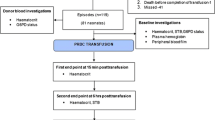Summary
The method of posthaemorrhagic blood volume (BV) determination by simple haematocrit measurement has been compared with the conventional isotope dilution technique.51Cr tagged erythrocytes and125IHSA were used to estimate RBC volume and plasma volume in non-starved male Sprague-Dawlay rats. Two series of experiments were carried out by two different investigatory groups. Haemorrhage was inflicted by 60 or 90 min of haemorrhagic hypotension at 70 mm Hg, causing 41% and 56% loss of the initial estimated BVs, respectively.
There was agreement in both series for the initial blood volume indices; RBC volume, 2.82 ml × 100 g−1 b.wt.; plasma volume 3.33 ml × 100 g−1 b.wt. andF cells , 0.91. Using the RBC volume data, the calculated residual BVs after haemorrhage corresponded accurately to the isotope measurements in both series. It is concluded that non-splenectomised rats may be used for accurate BV analysis after haemorrhage if the basal data for the strain used are known.
Similar content being viewed by others
References
Ackerman U (1978) Apparent escape rate of RIHSA and51Cr labelled erythrocytes from blood and volume-expanded rates. Am J Physiol 234:F386-F392
Barcroft J, Harris HA, Orahovats D, Weiss R (1925) A contribution to the physiology of the spleen. J Physiol (Lond) 60:443–456
Bearson SA (1954) Blood volume in health and disease. Bull NY Acad Med 30:750–776
Bearson SA, Yallow RS (1952) The use of K42 or P32 labelled erythrocytes and I131 tagged human serum albumin in simultaneous blood volume determinations. J Clin Invest 31:572–580
Carey LC, Curtin RA, Sapira JD (1976) Influence of haemorrhage on adrenal secretion, blood glucose and serum insulin in the awake pig. Ann Surg 183:185–192
Chien S, Dellenback RJ, Usami S, Burton DA, Gustavson PF, Magozinovic V (1973) Blood volume, haemodynamic and metabolic changes in haemorrhagic shock in normal and splenectomized dogs. Am J Physiol 225:866–879
Everett NB, Simmonds B, Lasher EP (1956) Distribution of blood (Fe59) and plasma (I131) volumes of rats, determined by liquid nitrogen freezing. Circ Res 4:414–419
Farnebo LO, Friedholm BB, Hamberger B, Hjelmdahl P, Westman L (1977) Cyclic AMP and metabolic substrates in haemorrhagic shock of the rat. Acta Chir Scand 143:9–14
Friedman SG, Pearce FJ, Drucker WR (1982) The role of blood glucose in defence of plasma volume during haemorrhage. J Trauma 22:86–91
Huang KE, Bonduriant JH (1956) Simultaneous estimation of plasma volume, red cell volume and thiocyanate space in anaesthetised normal and splenectomized rats. Am J Physiol 185:441–445
ICSH (International Committee for Standardization in Haematology) (1971) Recommended methods for radioisotope red-cell survival studies. Br J Haematol 21:241–250
Keith NM, Rowntree LG, Geraghty JJ (1915) A method for determination of plasma and blood volume. Arch Intern Med 16:547–576
Larsson H, Nylander G, Ohman U (1981) Post-haemorrhage changes in plasma water and extra-cellular fluid volumes in the rat. J Trauma 21:870–872
Miki K, Shiraki K, Sagawa S, Mortimoto T (1980) Use of haematocrit for estimating changes in plasma and red cell volumes in the rat. Jpn J Physiol 30:287–290
Mollinson PL (1967) Blood transfusion in clinical medicine, 4th edn. Blackwell, Oxford, pp 115–150
Reeve EB, Gregersen MI, Allen TH, Sear H (1953) Distribution of cells and plasma in the normal and splenectomized dog and its influence on blood volume estimates with P32 and T-1824. Am J Physiol 175:195–203
Reeve EB, Gregersen MI, Allen TH, Sear H, Walcott WW (1953) Validity of blood volume measurements in the bled splenectomized dog. Am J Physiol 175:211–217
Roth E, Lax LC, Maloney JV (1969) Ringers lactate solution and extracellular fluid volume in the surgical patient. Ann Surg 169:149–164
Seifert J, Messmer K (1971) Validity of blood volume determinations in haemorrhagic shock in rats. Eur Surg Res 3:306–316
Sterling K, Gray SJ (1950) Determination of circulating red cell volume in man by radioactive chromium. J Clin Invest 29:1614–1619
Swan H, Nelson AW (1971) Blood volume I: Critique: spun vs isotope haematocrit,125RIHSA vs51Cr RBC. Ann Surg 173:481–495
Wang L (1959) Plasma volume, cell volume, total blood volume andF cells factor in the normal and splenectomized Sherman rat. Am J Physiol 191:188–192
Ware J (1982) Fluid homeostasis in haemorrhage. Acta Chir Scand [Suppl] 511:1–56
Ware J, Ljungqvist O, Norberg KA, Nylander G (1982) Osmolar changes in haemorrhage. The effect of an altered nutritional status. Acta Chir Scand 148:641–646
Ware J, Norberg KA, Norman N, Nylander G (1982)51Cr EDTA determinations of the extracellular fluid volume in haemorrhage: A study with fed and starved rats. Acta Physiol Scand 116:235–238
Whigham H, Weil MH (1966) A model for the study of haemorrhagic shock in the rat. Development of the method. J Appl Physiol 21:1860–1863
Zweifach BW (1961) Aspects of comparative physiology of laboratory animals relative to the problem of experimental shock. Fed Proc 20 [Suppl 9]:18–29
Author information
Authors and Affiliations
Rights and permissions
About this article
Cite this article
Ware, J., Norman, M. & Larsson, M. Comparison of isotope dilution technique and haematocrit determination for blood volume estimation in rats subjected to haemorrhage. Res. Exp. Med. 184, 125–130 (1984). https://doi.org/10.1007/BF01852359
Received:
Accepted:
Issue Date:
DOI: https://doi.org/10.1007/BF01852359




